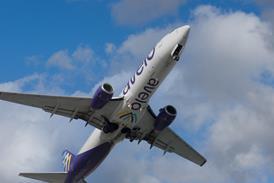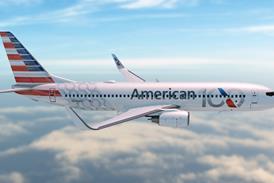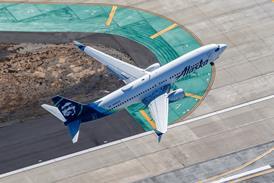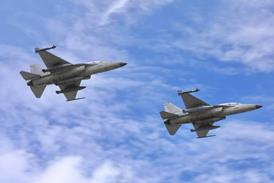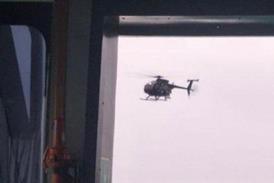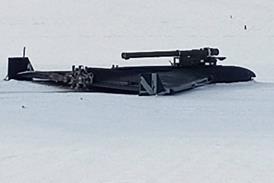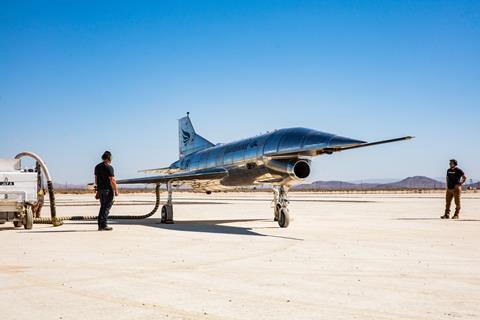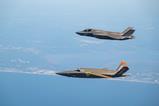Hypersonic developer Hermeus has completed the first flight with its Quarterhorse Mk 1 test vehicle.
The US start-up announced the much anticipated milestone on 27 May, noting the inaugural sortie took place from Edwards AFB in California’s High Desert region, home to the US Air Force (USAF) flight-test programme.
Although Hermeus does not reveal specifics about the flight’s profile, the company says the Quarterhorse Mk 1 test campaign is focused on validating high-speed take-off and landing of the uncrewed aircraft.
“The aircraft’s unique configuration – driven by high-speed flight – makes basic operations of take-off and landing distinctly challenging,” the company says.
Data collected during the flight validated the aircraft’s design and performance models, according to Hermeus, including aerodynamics, stability and control. Subsystems – including propulsion, fuel delivery, hydraulics, power and thermal management, and flight software – were successfully evaluated.
“The real-world flight data from Mk 1 provides significant technical value that we’re rolling into our next aircraft,” says Hermeus president Skyler Shuford.
Hermeus previously said the Mk 1’s design carries aerodynamic challenges, including a low-aspect ratio wing, high wing loading and a low thrust-to-weight ratio. The experimental design is powered by a single GE Aerospace J85 engine.
The Mk 1 is the second vehicle of Hermeus’ Quarterhorse line and the first flight-capable example. Hermeus completed ground testing the Mk 1 in December, culminating with a 130kt (240km/h) taxi test under full afterburner on a dry lake bed at Edwards.
The company plans to rapidly move into testing its next vehicle – the supersonic-capable Quarterhorse Mk 2. That aircraft has been in development for at least a year, with Hermeus revealing details of the design in April 2024.
The Mk 2 features a delta wing and a variable air intake, and will be “about the size” of a Lockheed Martin F-16, according to Hermeus. A single Pratt & Whitney F100 turbofan will power the Mk 2, which is to fly as fast as Mach 2.5.
Quarterhorse Mk 2 is currently being assembled in Atlanta, where Hermeus is based.
“It is on track to fly late this year,” the company says of Mk 2.
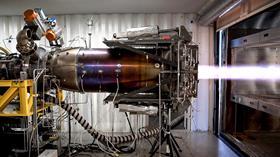
Hermeus has laid out the goal of developing and testing “one aircraft per year” under the Quarterhorse project. The company says Mk 1 went from “clean-sheet to flight-ready” in little more than one year.
Whether that timeline can be maintained remains to be seen. Hermeus had previously predicted that Quarterhorse Mk 1 would fly in summer of 2024, with the actual milestone coming nearly a year late.
Successive Quarterhorse aircraft will become significantly more complex as Hermeus seeks to achieve progressive gains in flight performance.
Notably, the F100 engine powering the Mk 2 will incorporate a proprietary pre-cooler technology being developed by Hermeus that will be key to breaking the M5.0 hypersonic barrier with the successor Quarterhorse Mk 3 aircraft.
Pre-cooling intake air before compression allows a standard turbofan engine to operate at higher speeds with greater efficiency and reduced performance degradation. The effect can be accomplished using a heat exchanger and a cryogenic fuel, such as liquid hydrogen.
Those efficiency gains are necessary to bridge the speed gap between the capabilities of a standard jet engine and the ramjet propulsion system needed to reach hypersonic speeds.
The physics of current high-speed ramjet designs require airspeeds of around M3.5 to achieve compression required to produce ignition and generate thrust.
Contemporary ramjet engines, and the related scramjet configuration, perform most efficiently at M4.0 and faster – well beyond the airspeed of even the most-capable jet fighters in service today.
Hermeus is developing a turbine-based combined-cycle (TBCC) propulsion system called Chimera that will integrate both the pre-cooled F100 and a separate ramjet engine into the Quarterhorse Mk 3 to achieve hypersonic speeds.
Other aerospace firms are taking different approaches to address the engine-transition problem.
Engine maker GE Aerospace has focused on developing a more-efficient ramjet that can take over at lower velocities, using a technique called rotating-detonation combustion to improve performance.
Meanwhile, California start-up Stratolaunch is using a rocket engine for its reusable Talon-A vehicle, which recently completed its first hypersonic flight.
That craft is powered by a single Hadley engine, developed by Colorado propulsion start-up Ursa Major.
Both Stratolaunch and Hermeus hope to make reusable hypersonic vehicles that will allow for regular and predictable high-Mach flights, both lowering the cost and shortening the time associated with developing new hypersonic technologies. Both firms have received support from the US military, in addition to private investment.
“The promise of routine hypersonic flight is an exciting capability for the joint team,” says Major General Scott Cain, commander of the USAF Test Center at Edwards.


